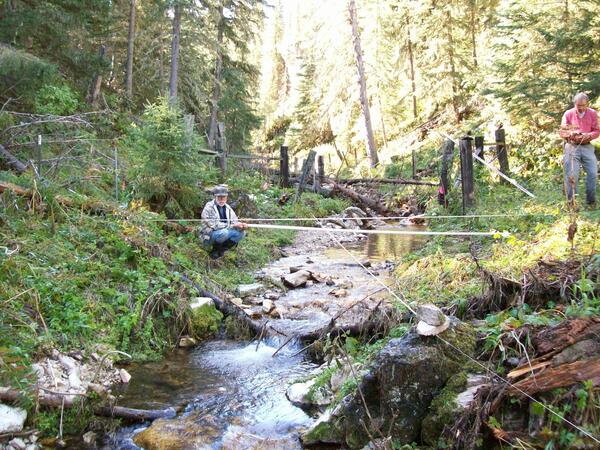USGS researchers running slope-area measurement in Ward Draw following storm of August 5, 2014. A group of thunderstorms produced greater than 4 inches of rain during four periods of progressively more intense rainfall across a small part of a relatively high-elevation area of the northern Black Hills on August 5, 2014.
Galen Hoogestraat
Galen Hoogestraat is a hydrologist for the Dakota Water Science Center (DWSC). Galen has been involved in various hydrologic investigations in the Dakotas including water-quality monitoring, stormwater, surface water models, and streamflow trends. Galen also serves as the DWSC reports specialist, social media coordinator, and is the current chair of the Western South Dakota Hydrology Conference.
Education and Certifications
B.S. Environmental Engineering, 2007, South Dakota School of Mines and Technology, Rapid City, South Dakota
M.S. Civil Engineering, 2009, South Dakota School of Mines and Technology, Rapid City, South Dakota
Science and Products
Water-quality data and trends in the Rapid Creek Basin, South Dakota, 1970–2020
Borehole analysis, single-well aquifer testing, and water quality for the Burnpit well, Mount Rushmore National Memorial, South Dakota
Stormwater quality of infrastructure elements in Rapid City, South Dakota, 2016–18
Western South Dakota Hydrology Conference
Real-time, Continuous Nitrate Monitoring of the Big Sioux River near Sioux Falls, South Dakota
Study to Examine Water-Quality Concerns within Mount Rushmore National Memorial
Water-Quality Monitoring of Canyon Lake
Model Scripts and Water-Quality Data for Trends in the Rapid Creek Basin, South Dakota, 1970–2020
Borehole Video and Aquifer Test Data for the Burnpit Well, Mount Rushmore National Memorial, South Dakota, 2020

USGS researchers running slope-area measurement in Ward Draw following storm of August 5, 2014. A group of thunderstorms produced greater than 4 inches of rain during four periods of progressively more intense rainfall across a small part of a relatively high-elevation area of the northern Black Hills on August 5, 2014.
Looking downstream at the 3rd Street wetland channel following an August 2014 runoff event in Rapid City, SD. Runoff from this wetland channel discharges into Rapid Creek.
Looking downstream at the 3rd Street wetland channel following an August 2014 runoff event in Rapid City, SD. Runoff from this wetland channel discharges into Rapid Creek.
Automated sampler bottles containing stormwater runoff from the Arrowhead drainage basin in Rapid City, SD, being processed in the laboratory. Stormwater runoff from urbanized lands is known to harm surface-water resources by increasing stream velocities, destroying natural habitat, and increasing pollutant loads in the receiving waters.
Automated sampler bottles containing stormwater runoff from the Arrowhead drainage basin in Rapid City, SD, being processed in the laboratory. Stormwater runoff from urbanized lands is known to harm surface-water resources by increasing stream velocities, destroying natural habitat, and increasing pollutant loads in the receiving waters.

U.S. Geological Survey Hydrologic Technician, Joel Petersen, has a buffalo audience while performing an indirect streamflow measurement survey at Beaver Creek near Pringle on August, 15, 2013.
U.S. Geological Survey Hydrologic Technician, Joel Petersen, has a buffalo audience while performing an indirect streamflow measurement survey at Beaver Creek near Pringle on August, 15, 2013.
Stormwater runoff monitoring site at Meadowbrook Golf course, near the outlet of the Arrowhead drainage basin in Rapid City, SD.
Stormwater runoff monitoring site at Meadowbrook Golf course, near the outlet of the Arrowhead drainage basin in Rapid City, SD.
Science and Products
Water-quality data and trends in the Rapid Creek Basin, South Dakota, 1970–2020
Borehole analysis, single-well aquifer testing, and water quality for the Burnpit well, Mount Rushmore National Memorial, South Dakota
Stormwater quality of infrastructure elements in Rapid City, South Dakota, 2016–18
Western South Dakota Hydrology Conference
Real-time, Continuous Nitrate Monitoring of the Big Sioux River near Sioux Falls, South Dakota
Study to Examine Water-Quality Concerns within Mount Rushmore National Memorial
Water-Quality Monitoring of Canyon Lake
Model Scripts and Water-Quality Data for Trends in the Rapid Creek Basin, South Dakota, 1970–2020
Borehole Video and Aquifer Test Data for the Burnpit Well, Mount Rushmore National Memorial, South Dakota, 2020

USGS researchers running slope-area measurement in Ward Draw following storm of August 5, 2014. A group of thunderstorms produced greater than 4 inches of rain during four periods of progressively more intense rainfall across a small part of a relatively high-elevation area of the northern Black Hills on August 5, 2014.
USGS researchers running slope-area measurement in Ward Draw following storm of August 5, 2014. A group of thunderstorms produced greater than 4 inches of rain during four periods of progressively more intense rainfall across a small part of a relatively high-elevation area of the northern Black Hills on August 5, 2014.
Looking downstream at the 3rd Street wetland channel following an August 2014 runoff event in Rapid City, SD. Runoff from this wetland channel discharges into Rapid Creek.
Looking downstream at the 3rd Street wetland channel following an August 2014 runoff event in Rapid City, SD. Runoff from this wetland channel discharges into Rapid Creek.
Automated sampler bottles containing stormwater runoff from the Arrowhead drainage basin in Rapid City, SD, being processed in the laboratory. Stormwater runoff from urbanized lands is known to harm surface-water resources by increasing stream velocities, destroying natural habitat, and increasing pollutant loads in the receiving waters.
Automated sampler bottles containing stormwater runoff from the Arrowhead drainage basin in Rapid City, SD, being processed in the laboratory. Stormwater runoff from urbanized lands is known to harm surface-water resources by increasing stream velocities, destroying natural habitat, and increasing pollutant loads in the receiving waters.

U.S. Geological Survey Hydrologic Technician, Joel Petersen, has a buffalo audience while performing an indirect streamflow measurement survey at Beaver Creek near Pringle on August, 15, 2013.
U.S. Geological Survey Hydrologic Technician, Joel Petersen, has a buffalo audience while performing an indirect streamflow measurement survey at Beaver Creek near Pringle on August, 15, 2013.
Stormwater runoff monitoring site at Meadowbrook Golf course, near the outlet of the Arrowhead drainage basin in Rapid City, SD.
Stormwater runoff monitoring site at Meadowbrook Golf course, near the outlet of the Arrowhead drainage basin in Rapid City, SD.








